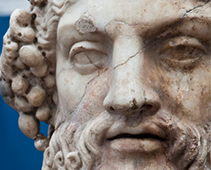Opening Hours
Tuesday - Sunday 11 a.m. - 5 p.m.
Closed on Mondays
Closed on the following days:
January 1st, June 5th, December 24th & 25th.
DEGAS AND SCULPTURE
THE COMPLETE COLLECTION OF DEGAS’ BRONZES AT THE GLYPTOTEK
Degas is known for his richly-coloured pastels and paintings of dancers, but perhaps most of all for his radical sculpture The Little Fourteen year-old Dancer. See her and 71 other figures in bronze by the great master at the Glyptotek.
A MODERNIST BREAKTHROUGH: THE LITTLE FOURTEEN YEAR-OLD DANCER
The Dancer was a tremendous sensation – and scandal – when she was presented at the 6th Impressionist Exhibition in Paris in 1881. Executed in wax, and dressed in a tulle skirt and with real hair, the dancer was radically different from any other contemporary work of sculpture. Opinions about her were many, and very divided, among both critics and the public. Today the sculpture is regarded as a modern masterpiece, particularly on account of the novelty and range of materials used.
Parallel with his considerable output of paintings and pastels, Degas modelled for his own use a large number of smaller wax figures. Around 150 of these dancers, bathing women and horses were discovered in his studio after his death and the best preserved of them – roughly half – were cast in bronze. As one of only four museums in the world, the Glyptotek has the complete collection of Degas’ studies of horses, bathing women and ballet dancers, executed in bronze.




